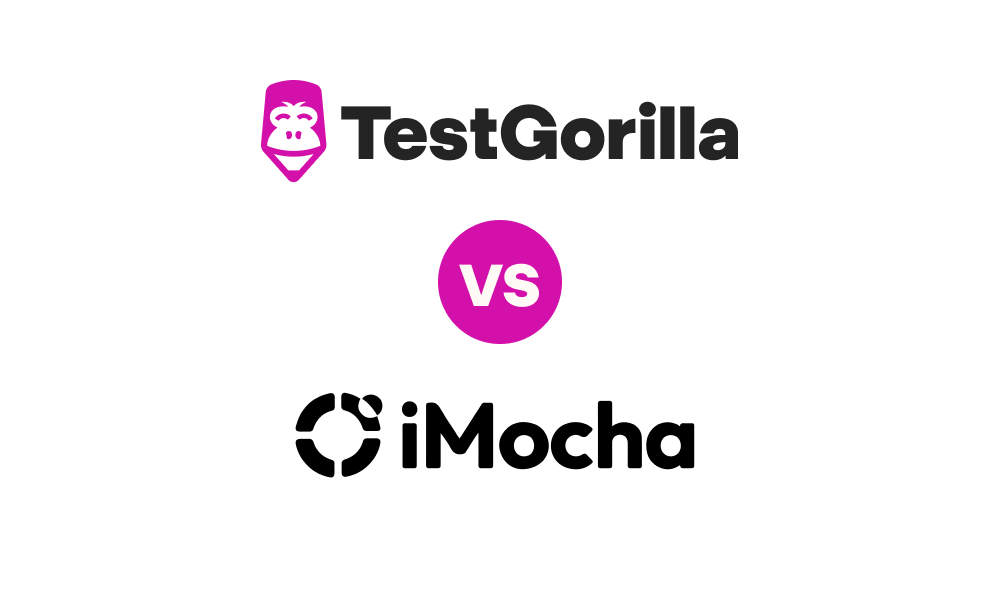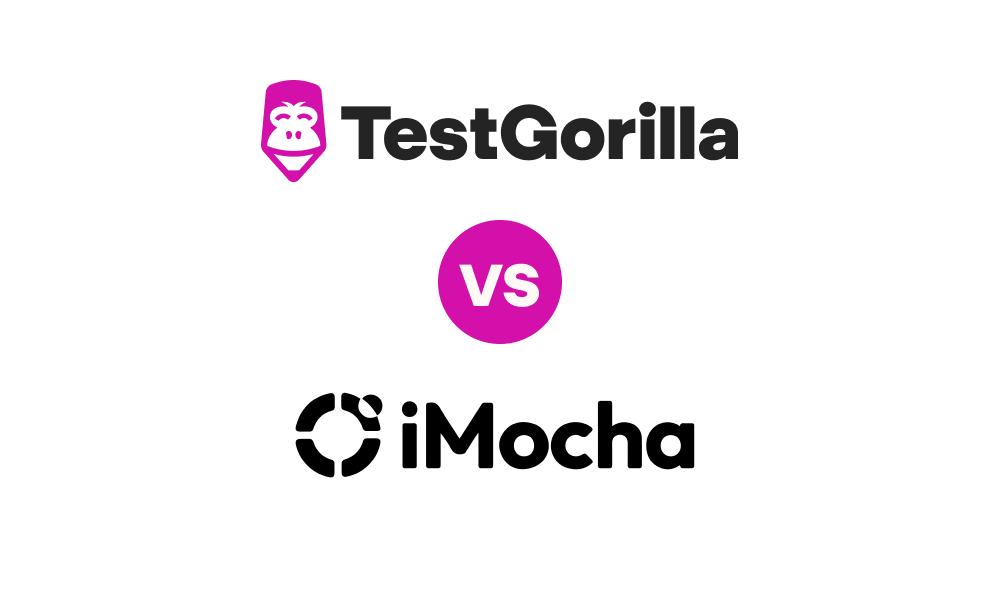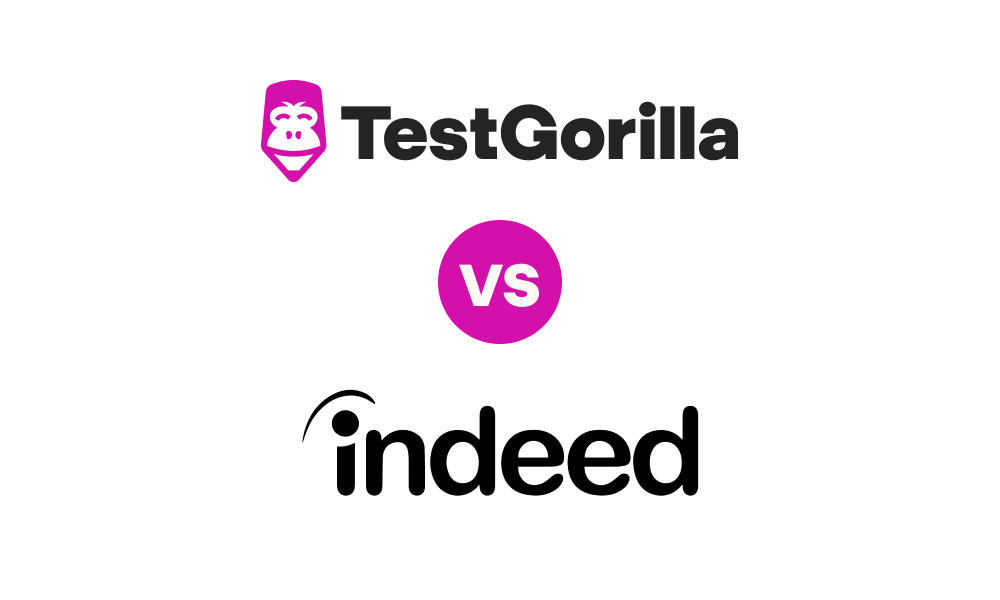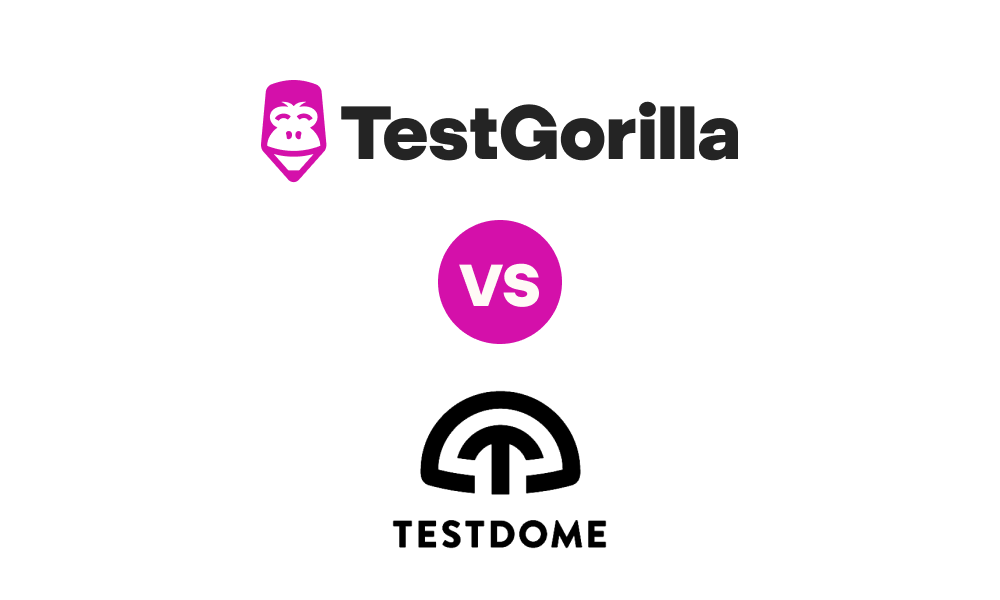21 full stack developer interview questions to assess candidates’ skills and technical knowledge
Full stack developers work on both the front-end and back-end of a website, so they play a key role in building robust web applications from start to finish.
They’re capable of creating complete and functional prototypes on their own, which is invaluable during the early stages of product development – and can significantly speed up the product iteration process.
When hiring for this role, you need to make sure the candidate you pick has the right mix of technical expertise and soft skills. How do you achieve that, though?
Pre-employment skills testing and the right interview questions for full stack developers will enable you to build a skills-first hiring process that can significantly reduce the risk of making a bad hire.
This method helps you get an accurate overview of all applicants’ skills and knowledge and enables you to make an objective decision without letting any bias creep into your decision.
To help you hire the best full stack developer for your team, we’ve selected the best interview questions you can ask candidates, along with skills tests you can use to assess their strengths and weaknesses.
We’ve grouped the questions into three categories, each to assess a specific skill set:
General interview questions
Front-end development interview questions
Back-end development interview questions
Table of contents
- 7 general interview questions for full-stack developers
- 7 front-end development interview questions for full stack developers
- 7 back-end development interview questions for full-stack developers
- How to evaluate full-stack developer skills
- Find a skilled full stack developer with the right interview questions and skills tests
7 general interview questions for full-stack developers
In this section, you’ll find some general questions you can use at the beginning of interviews, along with our guidelines on how to assess candidates’ answers.
1. Explain the concept and benefits of Test-Driven Development (TDD).
TDD is a software development approach where the development team writes tests before the actual code. The TDD cycle includes the following components:
Writing a test case that defines a desired improvement or new function, along with the code to fail it
Producing the minimum amount of code to pass that test
Refactoring the new code to acceptable standards
Expect candidates to mention some of the benefits of this approach, such as:
Enhanced code quality and reliability
Easier bug detection and prevention
Simpler change management
Better documentation
2. Describe the SOLID principles of object-oriented design.
The five SOLID principles of object-oriented design are:
S – Single Responsibility Principle (SRP): A class should have only one job or responsibility
O – Open/Closed Principle (OCP): Software entities (classes, modules, functions, etc.) need to be open for extension but closed for modification
L – Liskov Substitution Principle (LSP): Objects of a superclass should be replaceable with objects of a subclass without affecting the correctness of the program
I – Interface Segregation Principle (ISP): Clients should not have to depend on interfaces they don’t use
D – Dependency Inversion Principle (DIP): High-level modules should not depend on low-level modules but instead of abstractions
A strong answer would include examples to illustrate each principle.
3. How do you ensure your code is maintainable and easy to understand for other developers?
Skilled candidates will understand the importance of clean code. They might mention strategies they’d use, such as to:
Write clear variable and function names that reflect their purposes
Keep functions and classes small and focused
Document the code, especially for complex logic or decisions
Review their code and gather feedback from others
Use consistent coding standards to ensure uniformity
To go a step further, use our Clean Code test to evaluate applicants’ skills.
4. Tell us about a time when you contributed to improving the development process in your team.
Candidates should share a specific example where they identified a bottleneck or problem in the development process and took action to address it.
Look for stories that show that they’re able to:
Identify a problem and recognize the benefits of resolving it
Propose a practical and easy-to-implement solution, such as introducing a new tool or simplifying a workflow
Achieve a specific outcome with their intervention, such as increase productivity or reduce errors
Use our Problem Solving and Critical Thinking tests for a deeper understanding of candidates’ abilities to identify, analyze, and fix problems.
5. Share an example of how you've worked collaboratively in a cross-functional team.
Look for specific examples that illustrate candidates’ teamwork qualities – and, for more senior full-stack developers, their cross-functional leadership skills.
Skilled candidates might mention strategies such as:
Using collaboration tools such as Jira or Trello
Participating in regular stand-ups or sprint planning meetings
Looking for ways to harness everyone’s skills and expertise
6. Describe a time when you mentored a junior developer. What was your approach?
More experienced candidates will likely have mentored others in the past, but do they have the right approach to this? Are they able to tailor their mentoring to the other person’s needs and learning style? Do they know how to set clear goals and provide constructive feedback? Do they understand the importance of using mistakes as learning opportunities?
7. How do you handle feedback and revisions during the development process?
Expect skilled candidates to have an established process for incorporating feedback into their work, such as:
Thoroughly reviewing comments and asking for clarification if needed
Implementing necessary changes and revisions
Making sure the updated code meets the organization’s needs
Gracefully handling feedback is a sign of a high emotional intelligence and shows applicants’ willingness to learn and improve.
7 front-end development interview questions for full stack developers
Solid front end development knowledge is essential for any full stack developer. Evaluate candidates’ expertise with our questions below.
1. What are web components and how do they promote code reusability?
Web components are a set of web platform APIs allowing developers to create custom, reusable, and encapsulated HTML tags for web pages and apps.
Candidates might mention the main technologies involved, such as:
Custom Elements
Shadow DOM
HTML templates
ES Modules
Web components enable developers to build UI components that they can reuse across different projects without conflict with other parts of the code or third-party libraries.
2. Can you explain the box model in CSS and how it affects layout?
The CSS box model is the foundation of web layouts. It includes margins, borders, padding, and the actual content.
Candidates might explain that the total width and height of an element are calculated by adding up both values, affecting how elements are positioned and how they interact with each other on the page. Understanding the box model is crucial for creating clean layout design and for troubleshooting layout issues.
Gain a deeper insight into applicants’ CSS skills with our CSS test.
3. How does event delegation in JavaScript improve performance and maintainability?
Event delegation involves attaching a single event listener to a parent element rather than adding event listeners to multiple child elements.
This improves performance by reducing the memory footprint and eliminates the need to rebind event listeners when the DOM changes. The code is thus more maintainable and scalable, especially in dynamic applications where developers need to frequently remove or add elements.
4. Explain the difference between Flexbox and Grid in CSS.
Flexbox is a one-dimensional method for laying out items in rows or columns, providing a more efficient way to distribute space among items in a container.
Grid is a two-dimensional layout system, allowing for more complex layouts with rows and columns.
Candidates might also mention that while Flexbox is great for aligning content within a container (like vertically centering or evenly spacing items), Grid is better for complex page layouts and aligning content across both rows and columns.
5. What are service workers and how can they be used to improve web application performance?
Service workers are a type of web worker that act as a proxy between web applications, the browser, and the network. They can intercept and cache network requests, enabling offline use of web applications, speeding up load times, and reducing server load.
Look for answers that show candidates’ knowledge of practical use cases, such as background data syncing or push notifications.
6. Describe a project where you implemented responsive design. What were the biggest challenges?
A strong response would involve a detailed description of a project where the candidate implemented responsive design principles to ensure the app or website functioned well on different devices and screen sizes.
They might discuss challenges such as ensuring consistency across devices, managing images and media queries, and optimizing performance, and talk about strategies they used to overcome them.
7. How do you approach debugging a JavaScript issue that only appears in certain browsers?
Expect skilled full stack developers to have a systematic approach to debugging cross-browser compatibility issues. They might explain how they’d:
Use developer tools in different browsers to identify the issue
Check browser compatibility tables to see if the feature is supported across browsers
Identify the offending code snippet, for example by using a process of elimination
Use polyfills or transpilers
7 back-end development interview questions for full-stack developers
Below, you’ll find a selection of seven interview questions and sample answers to help you evaluate your candidates’ back-end development skills.
1. What are the differences between monolithic and microservices architectures?
A monolithic architecture is a software design model, in which all components of the application (user interface, business logic, database interactions, etc.) function together in a single, indivisible unit. It’s simpler to deploy but poses challenges in terms of scalability and flexibility.
A microservices architecture breaks down the application into a collection of smaller, interconnected services, each responsible for a specific business function. It offers better scalability and enables the use of different technologies for different services but is also more complex to deploy and manage.
2. What are some best practices for creating a RESTful API in Node.js?
Best practices candidates could mention include to:
Use URI resources and HTTP methods appropriately
Implement authentication and authorization
Ensure API security (f.e. by, using HTTPS, input validation against SQL injection, XSS)
Use pagination, sorting, and filtering for large data sets
Write clear, concise documentation for the API
3. What is Object-Relational Mapping (ORM)? Give examples of ORM frameworks.
ORM is a technique that enables developers to interact with a database using application code in their preferred programming language, rather than SQL. This makes data manipulation and retrieval easier by automatically converting data between incompatible type systems.
Examples of ORM frameworks include:
Sequelize and TypeORM for Node.js
Hibernate for Java
Entity Framework for .NET
Django ORM for Python
4. Can you explain the concept of dependency injection and its benefits?
Dependency injections are design patterns used to manage dependencies between objects. In this way, rather than have objects create dependencies, dependencies are injected at runtime, typically by a framework.
Benefits to look for include:
Increased modularity
Easier unit testing
Improved code maintainability
5. What are the benefits and drawbacks of using GraphQL over REST?
Skilled developers will have a strong understanding of GraphQL and REST and be able to explain the strengths and weaknesses of each approach.
GraphQL enables efficient data retrieval by allowing clients to specify exactly what data they need. It also facilitates request management. However, it makes backend query optimization more difficult and might lead to potential performance issues for complex queries.
REST is simpler, stateless, and provides broad support across platforms and tools. It might, however, lead to over-fetching data and the need for multiple endpoints to retrieve related resources.
6. Describe a situation where you had to optimize server performance. What strategies did you use?
Here, candidates should explain their diagnostic process and the optimization strategies they used.
They might explain how they identified performance bottlenecks with the help of monitoring tools (such as New Relic or Datadog) to track server load, response times, and resource usage.
Then, they’d explain the specific strategies they used to improve performance, such as:
Implementing caching mechanisms to reduce database load
Optimizing queries, adding indexes, or using more efficient data structures to reduce database access time
Distributing traffic across multiple servers to ensure no single server becomes a bottleneck
Analyzing the code to identify inefficiencies and refactor them
Upgrading server hardware to handle increased load
The best candidates might also mention how they measured the impact of their optimizations by comparing server performance before and after.
7. How would you refactor a legacy back-end system?
A comprehensive answer might include the following steps:
Do an initial assessment: Evaluate the system to understand its architecture, dependencies, and the scope of the required changes
Identify improvement areas: Focus on parts of the system that would benefit most from refactoring, such as those with high complexity, technical debt, or critical performance issues
Perform incremental refactoring: Adopt an incremental approach to refactoring, making small, manageable changes that can be easily tested and rolled back
Do testing: Ensure full test coverage before starting the refactoring process to detect regressions and other issues introduced by the changes
Update documentation: Describe the changes made during refactoring
How to evaluate full-stack developer skills
A full-stack developer must possess excellent technical knowledge and the ability to work on front-end technologies (like HTML, CSS, and JavaScript) and back-end technologies (like Python, Ruby, or Node.js).
A resume doesn’t reflect the actual knowledge a candidate possesses. This is why it is necessary to shortlist candidates based on what they know, not on what’s written on paper.
Pre-employment skill tests like the ones we offer at TestGorilla enable you to evaluate candidates based on specific criteria and shortlist the ones who truly meet the requirements of the role.
You can combine up to five skill tests of your choice to create a custom assessment for full-stack developers. Here are some of the tests that you may want to consider:
PHP (Coding): Intermediate-Level Algorithms: Evaluate applicants’ ability to write code in PHP that meets specific requirements.
Algorithms for Software Engineering: Identify developers who are proficient with algorithms, such as growth functions, sorting algorithms, heaps, and more.
CSS: Front-end development requires excellent CSS knowledge. Identify candidates who have it with the help of this test.
GitHub: Find candidates who are skilled at managing large codebases and collaborating with others.
HTML5: Use this test to identify candidates who are proficient in using HTML5 to develop websites and web applications.
JavaScript (Coding): Evaluate candidates’ ability to program a small algorithm in JavaScript.
You can also add cognitive ability tests and personality and culture tests to gain deeper insights into candidates’ cognitive skills, behavior, and motivation.
Find a skilled full stack developer with the right interview questions and skills tests
Candidates’ ability to seamlessly transition between front-end and back-end development is essential for delivering high-quality products on time and within budget.
This is why it is important to use a thorough evaluation process for screening and shortlisting candidates. Resumes and portfolios, although helpful in providing a general sense of applicants’ experience, aren’t a reflection of their skills and knowledge.
With TestGorilla, you can hire the best full-stack developer for your company without bias. Sign up for a free demo to speak with one of our team members – or check out our free trial to start evaluating candidates today.
Related posts
Hire the best candidates with TestGorilla
Create pre-employment assessments in minutes to screen candidates, save time, and hire the best talent.
Latest posts
The best advice in pre-employment testing, in your inbox.
No spam. Unsubscribe at any time.

Hire the best. No bias. No stress.
Our screening tests identify the best candidates and make your hiring decisions faster, easier, and bias-free.
Free resources
This checklist covers key features you should look for when choosing a skills testing platform
This resource will help you develop an onboarding checklist for new hires.
How to assess your candidates' attention to detail.
Learn how to get human resources certified through HRCI or SHRM.
Learn how you can improve the level of talent at your company.
Learn how CapitalT reduced hiring bias with online skills assessments.
Learn how to make the resume process more efficient and more effective.
Improve your hiring strategy with these 7 critical recruitment metrics.
Learn how Sukhi decreased time spent reviewing resumes by 83%!
Hire more efficiently with these hacks that 99% of recruiters aren't using.
Make a business case for diversity and inclusion initiatives with this data.


















